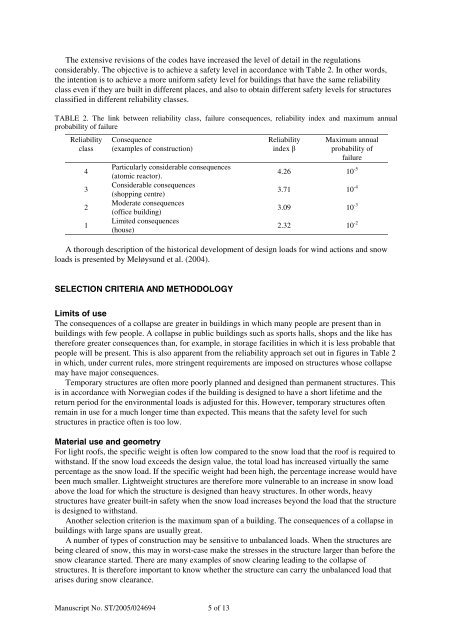Lisø PhD Dissertation Manuscript - NTNU
Lisø PhD Dissertation Manuscript - NTNU
Lisø PhD Dissertation Manuscript - NTNU
Create successful ePaper yourself
Turn your PDF publications into a flip-book with our unique Google optimized e-Paper software.
The extensive revisions of the codes have increased the level of detail in the regulations<br />
considerably. The objective is to achieve a safety level in accordance with Table 2. In other words,<br />
the intention is to achieve a more uniform safety level for buildings that have the same reliability<br />
class even if they are built in different places, and also to obtain different safety levels for structures<br />
classified in different reliability classes.<br />
TABLE 2. The link between reliability class, failure consequences, reliability index and maximum annual<br />
probability of failure<br />
Reliability<br />
class<br />
4<br />
3<br />
2<br />
1<br />
Consequence<br />
(examples of construction)<br />
Particularly considerable consequences<br />
(atomic reactor).<br />
Considerable consequences<br />
(shopping centre)<br />
Moderate consequences<br />
(office building)<br />
Limited consequences<br />
(house)<br />
<strong>Manuscript</strong> No. ST/2005/024694 5 of 13<br />
Reliability<br />
index β<br />
Maximum annual<br />
probability of<br />
failure<br />
4.26 10 -5<br />
3.71 10 -4<br />
3.09 10 -3<br />
2.32 10 -2<br />
A thorough description of the historical development of design loads for wind actions and snow<br />
loads is presented by Meløysund et al. (2004).<br />
SELECTION CRITERIA AND METHODOLOGY<br />
Limits of use<br />
The consequences of a collapse are greater in buildings in which many people are present than in<br />
buildings with few people. A collapse in public buildings such as sports halls, shops and the like has<br />
therefore greater consequences than, for example, in storage facilities in which it is less probable that<br />
people will be present. This is also apparent from the reliability approach set out in figures in Table 2<br />
in which, under current rules, more stringent requirements are imposed on structures whose collapse<br />
may have major consequences.<br />
Temporary structures are often more poorly planned and designed than permanent structures. This<br />
is in accordance with Norwegian codes if the building is designed to have a short lifetime and the<br />
return period for the environmental loads is adjusted for this. However, temporary structures often<br />
remain in use for a much longer time than expected. This means that the safety level for such<br />
structures in practice often is too low.<br />
Material use and geometry<br />
For light roofs, the specific weight is often low compared to the snow load that the roof is required to<br />
withstand. If the snow load exceeds the design value, the total load has increased virtually the same<br />
percentage as the snow load. If the specific weight had been high, the percentage increase would have<br />
been much smaller. Lightweight structures are therefore more vulnerable to an increase in snow load<br />
above the load for which the structure is designed than heavy structures. In other words, heavy<br />
structures have greater built-in safety when the snow load increases beyond the load that the structure<br />
is designed to withstand.<br />
Another selection criterion is the maximum span of a building. The consequences of a collapse in<br />
buildings with large spans are usually great.<br />
A number of types of construction may be sensitive to unbalanced loads. When the structures are<br />
being cleared of snow, this may in worst-case make the stresses in the structure larger than before the<br />
snow clearance started. There are many examples of snow clearing leading to the collapse of<br />
structures. It is therefore important to know whether the structure can carry the unbalanced load that<br />
arises during snow clearance.














![Diagnosis and FTC by Prof. Blanke [pdf] - NTNU](https://img.yumpu.com/12483948/1/190x245/diagnosis-and-ftc-by-prof-blanke-pdf-ntnu.jpg?quality=85)

